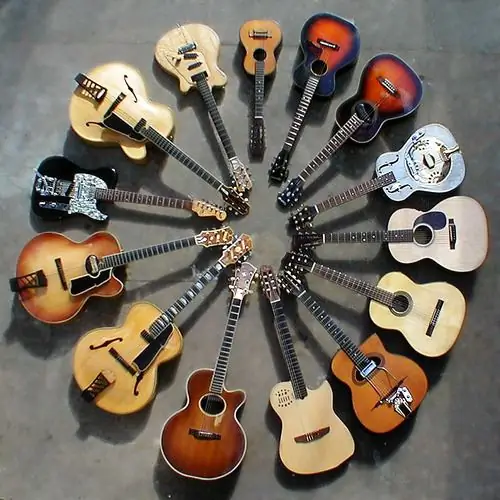- Author Antonio Harrison [email protected].
- Public 2023-12-16 07:44.
- Last modified 2025-01-22 21:44.
The first question for a novice musician is: "Where to start, how to choose an instrument and not make a mistake when making such a choice?" The offer is great, there are many good guitars, but there are also many Chinese fakes.

So, you've definitely decided that you want to practice playing the guitar. Naturally, you do not want to play with a stick and line. It makes sense to go to the store and consult with the seller. But! Not all sellers understand their product, many have a rather simple goal - to sell the product. Therefore, feel free to take your friend, who has been playing for a long time, and go with him to the store. He certainly will not deceive you. As a rule, a person who has played the guitar for at least a year and has held several guitars of different brands and price categories in his hands can make the right choice. Believe me, this is the most correct way out in this situation.
But what if you don't have such a friend? In that case, here are some tips for your attention.
1. Do not purchase the instrument out of the box !!! Perhaps the most important rule! Feel free to ask the seller to take out the guitar and give it to you to "feel". Examine it for defects (this will be discussed below). Ask to tune your guitar so you can hear how it sounds. In fact, the choice mainly comes down to the sound of the instrument, ideally you yourself should take a couple of chords and at least just slide over the strings.

2. Check the top and bottom decks as well as the shell for damage. There should be no cracks, chips, dents. All this affects the sound of the instrument. Also check the guitar cover. Paint and varnish must be applied evenly.
3. Neck and frets. The neck should not be crooked, twisted, cracked. Check if the neck is firmly and evenly glued, or secured to the anchor (bolt). The frets must be "in place", must not fall out of the fretboard, stick out above and below the neck, otherwise there is a chance of getting hurt while playing.
4. Nut and saddle. The straps must be firmly secured, the nut stand must not lag behind the deck or play (move back and forth).
5. Tuners. The tuning pegs should not creak when turning - a sign that they are poorly lubricated, but nothing should leak from them either, this may indicate that the tuning pegs are defective, but they were simply generously greased with oil so that they do not creak.
6. Strings. This is, perhaps, the only thing that you can not get too hung up on. On budget guitars, the strings from the factory are very mediocre and most likely you will change them after purchase.
7. Price. The price of the tool depends entirely on your wallet. I will say one thing, if you are a beginner, the price of a classical guitar should be at least 3000-3500 rubles, if it is acoustics, then here it is already at least 4000-5000.
P. S. Remember! Sound first! If the guitar is assembled perfectly, but you don't like the sound, then you can hardly play for the soul. Good luck with your tool selection!






